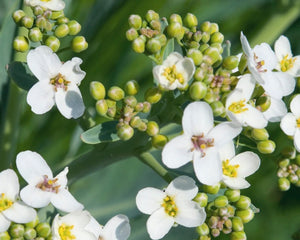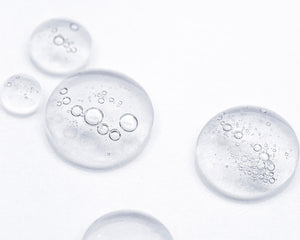
B

INCI: Bakuchiol
What is Bakuchiol?
Bakuchiol is a natural compound derived from the seeds of a plant native to India, **Psoralea corylifolia**. It is an active ingredient with multiple beneficial properties for the skin, similar to those of retinol, which is why some have referred to it as "plant-based retinol." Its natural origin and safety profile make it a highly interesting ingredient in modern cosmetics.
Among its main properties are antioxidant, anti-inflammatory, and depigmenting actions.
Properties of Bakuchiol
Its antioxidant activity comes from its molecular structure, which allows it to effectively neutralize free radicals. Additionally, it has powerful anti-inflammatory properties that help reduce irritation and redness of the skin. Furthermore, Bakuchiol has been shown to possess depigmenting action, capable of inhibiting melanin production and lightening skin spots. This natural ingredient also has antimicrobial activity, making it useful for combating infections. Finally, Bakuchiol also has rejuvenating effects and improves skin texture, offering benefits similar to those of retinol, but without its potential irritating effects.
If you want to learn more about this active ingredient, you can read this article.
C

INCI: Crambe Abyssinica seed oil
What is Crambe?
Abyssinian oil is a vegetable oil extracted from the seeds of the Crambe abyssinica plant, native to ancient Abyssinia, now Ethiopia. Crambe oil is obtained through a cold-pressing process of the seeds, preserving its natural properties.
Properties of Abyssinian or Crambe Oil:
Crambe oil is widely used in the cosmetics and personal care industry due to its excellent emollient, occlusive, and conditioning properties for the skin. Additionally, it has notable antioxidant activity that helps protect the skin against premature aging and presents regenerative and nourishing properties, providing hydration and softness to the skin and hair. Due to its high content of Omega 6 and 9 fatty acids, Crambe oil also has a smoothing effect and improves the skin barrier.
L

INCI: Lactobionic Acid
What is Lactobionic Acid?
This polyhydroxy acid (PHA) is an organic acid obtained from lactose. It is a natural compound derived from plant and dairy sources. This acid is produced through a controlled oxidation process of lactose.
Properties of Lactobionic Acid
Lactobionic acid is a polyhydroxy acid (PHA) used in cosmetics for its hydrating and antioxidant action. Its exfoliating properties help remove dead skin cells, gently improving skin texture and tone. Additionally, it has moisturizing and hydrating effects, providing radiance and softness to the skin. Its antioxidant activity makes it a highly interesting anti-aging ingredient. At higher concentrations, lactobionic acid has brightening properties that can help reduce spots and uneven pigmentation.
N

INCI: Niacinamide
What is Niacinamide?
Niacinamide, also known as vitamin B3, is an organic compound derived from niacin. It is a naturally occurring ingredient found in foods such as legumes, meats, fish, and dairy products. Niacinamide is widely used in the field of cosmetics and dermatology for its multiple benefits for the skin.
Properties of Niacinamide
Niacinamide has excellent moisturizing properties that help maintain the skin's hydration levels. Additionally, it has a normalizing effect on sebum production, making it an ideal ingredient for oily or acne-prone skin. It also has anti-inflammatory and antioxidant properties, contributing to calming the skin and protecting it from premature aging. Studies have shown that this active ingredient can inhibit melanin transfer, helping to reduce spots and even out skin tone.
P

INCI: Phytic Acid
What is Phytic Acid?
Phytic acid is a natural compound found in whole grains, seeds, nuts, and some vegetables.
Properties of Phytic Acid
Phytic acid is an increasingly used ingredient in cosmetics. It has antioxidant properties. It is used as a chelator to block harmful heavy metals for the skin. Additionally, phytic acid also has antimicrobial and anti-inflammatory actions, making it an interesting ingredient for the care of sensitive skin.
R

INCI: Rosmarinus Officinalis Leaf Extract*
What is Rosemary?
Rosemary extract is obtained from the dried leaves and flowers of the rosemary plant (Rosmarinus officinalis), an aromatic herb native to the Mediterranean region. This plant has been traditionally used in medicine and cooking for its multiple beneficial properties.
Properties of Rosemary Extract
It has notable antioxidant properties that help protect the skin from oxidative stress and premature aging. Its stimulating and toning effects improve blood circulation and provide radiance to the complexion. Additionally, rosemary extract has antimicrobial and antiseptic activity, making it an agent of interest for the care of skin with imperfections or acne-prone tendencies. Moreover, its herbaceous and refreshing fragrance offers a pleasant sensory experience.
(*) Ingredient from controlled organic farming

INCI: Rosa Damascena Flower Water*
What is Damask Rose?
The Damask Rose is a variety of rose originally cultivated in the city of Damascus (Syria). It is known for its intense and delicate floral aroma. This rose has been used for centuries in traditional medicine for the production of essential oils and valuable floral waters.
Properties of Damask Rose Water
Damask Rose Water has moisturizing and soothing properties that help keep the skin firm and radiant. It has calming and anti-inflammatory effects, making it an ideal ingredient for sensitive or reactive skin. It also provides antioxidant properties. Its delicate floral aroma offers a pleasant sensory experience during application.
(*) Ingredient from controlled organic cultivation
S

INCI: Hippophae Rhamnoides Fruit Extract*
What is Sea Buckthorn?
Hippophae rhamnoides fruit extract, commonly known as sea buckthorn, is rich in vitamin C, omega fatty acids, and antioxidants.
Properties of Sea Buckthorn
This extract is renowned for its moisturizing and regenerative properties, helping to improve skin elasticity and combat signs of aging. It’s also used in treatments for burns and wounds thanks to its healing effects.
(*) Ingredient from controlled organic cultivation



